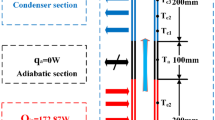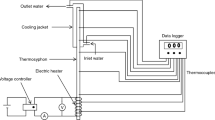Abstract
An experimental and numerical investigations are conducted on a Two Phase Closed Thermosyphon (TPCT) charged with six working fluids; namely (water, methanol, ethanol, acetone, butanol and R134a) with filling ratios (40, 50, 60, 70 and 100 %). The TPCT is made from a 0.016 m diameter copper tube, which consists of a 0.15 m evaporator, 0.1 m adiabatic and 0.15 m condenser sections, respectively. Thermocouples are located in the core and on the wall of the TPCT. The main objectives of the experimental investigation are to analyze the effect of the working fluid and filling ratio (liquid inventory) under heat inputs (20–120 W) with a fixed condenser cooling temperature of (25 °C) on the thermal performance of the TPCT. The results are compared with a simulation model using finite difference method in three dimensional cylindrical coordinates by using FORTRAN. The correlations of the phase change for the TPCT based on the theory of thermal resistance are used in the evaporator and condenser sections. The agreement between theoretical and experimental results is shown to be accurate within 10 %. The results showed that the maximum heat transport ability is associated with using of water and acetone where it is compared with other fluids under the same range of operating temperatures of 35–50 °C. This is the range between lowest and highest temperatures for the sub-tropical climates.













Similar content being viewed by others
Abbreviations
- A:
-
Surface area (m2)
- c:
-
Specific heat (kJ/kg k)
- C:
-
Factor
- D:
-
Diameter (m)
- g:
-
Gravitational acceleration (m/s2)
- h:
-
Heat transfer coefficient (W/m2 K)
- hfg :
-
Latent heat of vapourisation (J/kg)
- I:
-
Current (A)
- k:
-
Thermal conductivity (W/m K)
- l:
-
Length (m)
- \( \mathop m\limits^{ \circ } \) :
-
Mass flow rate (kg/s)
- p:
-
Pressure (Pa)
- P:
-
Electric heat input (Watt)
- Q:
-
Heat transfer rate (W)
- Q:
-
Heat flux (W/m2)
- R:
-
Thermal resistance (°C/W)
- T:
-
Temperature (°C)
- V:
-
Voltage (V)
- θ:
-
Angle (°)
- μ:
-
Dynamic viscosity (N s/m2)
- ρ:
-
Density (kg/m3)
- σ:
-
Surface tension (N/m)
- wout:
-
Water outlet
- win:
-
Water inlet
- atm:
-
Atmospheric
- c:
-
Condenser section
- cu:
-
Copper
- e:
-
Evaporator section
- exp:
-
Experimental
- f:
-
Fluid
- sat:
-
Saturation
- th:
-
Theoretical
- wout:
-
Water outlet
- win:
-
Water inlet
- v:
-
Vapour
References
Reay D, Kew P (2006) Heat pipes theory design and applications, 5th edn. Butterworth-Heinemann, Oxford
Shabgard H, Allen M, Sharifi N, Benn S, Faghri A, Bergman T (2015) Heat pipe heat exchangers and heat sinks: opportunities, challenges, applications, analysis, and state of the art. Int J Heat Mass Transf 89:138–158
Jouhara H, Robinson AJ (2010) Experimental investigation of small diameter two-phase closed thermosyphons charged with water, FC-84, FC-77 and FC-3283. Appl Therm Eng 30:201–211
Ji L, Wenkai T, Lucang L (2015) A thermosyphon heat pipe cooler for high power LEDs cooling. Heat Mass Transfer. doi:10.1007/s00231-015-1679-z
Srimuang W, Amatachaya P (2012) A review of the applications of heat pipe heat exchangers for heat recovery. Renew Sustain Energy Rev 16:4303–4315
Richard HB, Hassam CN, John CK (2014) Passive energy recovery from natural ventilation air streams. Appl Energy 113:127–140
Chaoling H, Linjiang Z (2015) Study on the heat transfer characteristics of a moderate-temperature heat pipe heat exchanger. Int J Heat Mass Transf 91:302–310
Jafari D, Franco A, Filippeschi S, Di Marco P (2016) Two-phase closed thermosyphons: a review of studies and solar applications. Renew Sustain Energy Rev 53:575–593
Laubscher R, Dobson R (2013) Theoretical and experimental modelling of a heat pipe heat exchanger for high temperature nuclear reactor technology. Appl Therm Eng 61:259–267
Harley C, Faghri A (1994) Complete transient two-dimensional analysis of two-phase closed thermosyphons including the falling condensate film. J Heat Transf 116:418–426
Joudi KA, Al-Tabbakh AA (1999) Computer simulation of a two phase thermosyphon solar domestic hot water heating system. Energy Convers Manag 40:775–793
Behrooz MZ, Hadi S (2010) Heat transfer characteristics of a two-phase closed thermosyphon using different working fluids. Heat Mass Transf 46:307–314
Fadhl B, Wrobel LC, Jouhara H (2013) Numerical modelling of the temperature distribution in a two-phase closed thermosyphon. Appl Therm Eng 60:122–131
Fadhl B, Wrobel LC, Jouhara H (2015) CFD Modelling of a two-phase closed thermosyphon charged with R134a and R404a. Appl Therm Eng. doi:10.1016/j.applthermaleng.2014.12.062
Behrooz MZ, Majid B, Ali M (2015) Experimental study on the performance characteristics of an enhanced two-phase loop thermosyphon. Heat Mass Transf. doi:10.1007/s00231-015-1518-2
Taylor JR (1997) An introduction to error analysis: the study of uncertainties in physical measurements. University Science Books, Sausalito
Bergman TL, Lavine AS, Incropera FP, Dewitt DP (2011) Fundamentals of heat and mass transfer, 7th edn. Wiley, New York
Zuo ZJ, Faghri A (1998) A network thermodynamic analysis of the heat pipe. Int J Heat Mass Transf 11:1473–1484
Lemmon EW, Huber ML, Linden MD (2013) NIST standard reference database 23: reference fluid thermodynamics and transport properties-REFPROP. National Institute of Standards and Technology, Standard Reference Data Program, Gaithersburg 2013; Version 9.1
Imura H, Kusada H, Oyata J, Miyazaki T, Sakamoto N (1977) Heat transfer in two-phase closed-type thermosyphons. Trans Jpn Soc Mech Eng 22:485–493
Park YJ, Kang HK, Kim CJ (2002) Heat transfer characteristics of a two-phase closed thermosyphon to the fill charge ratio. Int J Heat Mass Transf 45:4655–4661
Kannan M, Senthil R, Baskaran R, Deepanraj B (2014) An experimental study on heat transfer capability of a two phase thermosyphon charged with different working fluids. Am J Appl Sci 4:584–591
Author information
Authors and Affiliations
Corresponding author
Rights and permissions
About this article
Cite this article
Eidan, A.A., Najim, S.E. & Jalil, J.M. Experimental and numerical investigation of thermosyphone performance in HVAC system applications. Heat Mass Transfer 52, 2879–2893 (2016). https://doi.org/10.1007/s00231-016-1800-y
Received:
Accepted:
Published:
Issue Date:
DOI: https://doi.org/10.1007/s00231-016-1800-y




